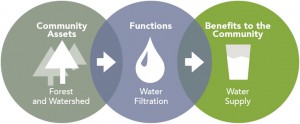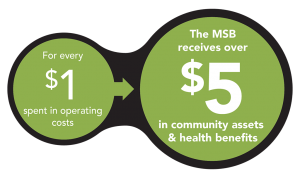Keeping the character
of the valley
It’s working for us all the time

This report uses accepted economic assessment tools to valuate the benefits we receive from 13 different land types in the Mat-Su Borough. The study looks at our natural resources as economic assets that benefit our community over—time like bridges and roads. For example, wetlands are nurseries for salmon, which provide a tangible boost to our economy. Wetlands also help us avoid costs because they act as sponges to moderate potential flooding, function as “free” waste treatment, and are part of our water supply system. Not only do we sit back and reap the benefits, assets like these are self-maintaining and, when managed sustainably, have longer lifespans than man-made infrastructure. Consider the cost to build, maintain, and ultimately replace, a water-filtration plant as a substitute for naturally filtered groundwater. It’s substantial and this example is just one benefit from one land type.
What’s it all worth? approximately $35 billion of direct inputs (e.g. salmon) plus avoided costs (e.g. water treatment facilities) to our economy each year, or an estimated $1 trillion over 100 years. When these asset values are considered in land-use decisions by governments, private owners, and organizations, we all benefit.
Return On Investment Analysis
Economic benefits of trails, parks, and open space in the Mat-Su
What can a trail contribute to the economy of the Mat-Su? Think of it this way: trails lead to salmon streams, which leads to fishing, which requires the purchase of gear, and services, like food, gas, and lodging, and local guiding businesses. Call it exercise or call it going fishing, the end result is revenue for the valley and healthier living for residents.
And that’s not all. Proximity to open spaces, streams and lakes increases property values. Agriculture and wild food harvests fill the larder of the locals while also adding to health benefits through the gathering as well as the eating. Fields act as fire buffers. Marshes provide flood protection. Visitors attracted to the great outdoors of the Mat-Su stay the night and pay a bed tax. All of these add up to direct and indirect benefits to the Mat-Su Borough.
This report quantifies what we get back from our trails, parks and open spaces for every dollar we put in. In simple terms, when we spend $1 on the trail to that salmon stream, we can look forward to $5 in return. And that’s being conservative. It’s something to think about the next time funding for trails, parks and public open spaces shows up on the ballot.
